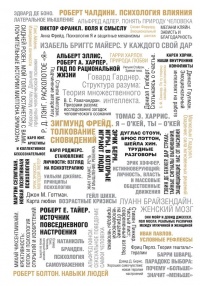Читать книгу "Наука мудрости - Ли Росс"
Шрифт:
Интервал:
Закладка:
10. Статистика по ожирению. Centers for Disease Control. (2010). National obesity trends. Washington Post, p. A19. http://www.washingtonpost.com/wpdyn/content/article/2010/04/29/ AR2010042903669.html
11. Статистика по диетам. Dieting on a budget. Consumer Reports; http://www.consumerreports.org/cro/2012/04/dieting-on-a-budget/index.htm. Nibbles: Survey shows 41 percent of Americans are dieting. Calorielab, retrieved 2012–08–03. http://calorielab.com/news/2007/05/08/nibbles-survey-shows-41-percent-of-Americans-are-dieting/.
12. Изменение внешних условий приема пищи. Wansink, B. (2006). Mindless eating: Why we eat more than we think. New York: Bantum.
13. Размер тарелок. Van Ittersum, K. & Wansink, B. (2012). Plate size and color suggestibility: The Delboeuf illusion’s bias on serving and eating behavior. Journal of Consumer Research, 39, 215–228.
14. Исследования Милгрэма. Milgram, S. (1974). Obedience to authority. An Experimental View. New York: Harper.
15. Эксперимент с придумывающим вопросы и отвечающим. Ross, L., Amabile, T.M., & Steinmetz, J.L. (1977). Social roles, social control, and biases in social-perception processes. Journal of Personality and Social Psychology, 35, 485–494.
16. Эссенциализм («сущностная» интерпретация мира). Cimpian, A., & Salomon, E. (2014) The inherence heuristic: An intuitive means of making sense of the world, and a potential precursor to psychological essentialism. Behavioral and Brain Sciences, 37, 461–527.
17. Рефлекторный характер убеждений: Gilbert, D.T. (1991). How mental systems believe. American Psychologist, 46, 107–119.Gilbert, D.T. (2006). Stumbling on happiness. New York: Knopf.
18. Ураган «Катрина». Stephens, N.M., Hamedani, M.G., Markus, H.R., Bergsieker, H.B., & Eloul, L. (2009). Why did they “choose” to stay? Perspectives of Hurricane Katrina observers and survivors. Psychological Science, 20, 878–886. Shapiro, I. & Sherman, A. (2005). Essential facts about the victims of Hurricane Katrina. Washington, DC: Center for Budget and Policy Priorities.
19. Неимущие. Mullainathan, S. & Shafir, E. (2013). Scarcity: Why having too little means so much. New York: Times Books.
20. Джефферсон. Finkelman, P. (2012, November 30). The monster of Monticello. New York Times.
21. Исследования Мишела. Mischel, W. (1968). Personality and Assessment. New York: Wiley. Mischel, W. (2004). Toward an integrative science of the person. Annual Review of Psychology, 55, 1–22. Mischel, W. (2014). The Marshmellow Test. New York: Little-Brown.
3. Что как называется
1. Рузвельт на церемонии подписания. http://www.ssa.gov/history/
2. Рузвельт о плане Бевериджа. Perkins, F. (1946). The Roosevelt I Knew. New York: Viking Press.
3. «Уолл-стрит» и «Сообщество». Liberman, V., Samuels, S.M. & Ross, L. (2002). The name of the game: Predictive power of reputations vs situational labels in determining prisoner’s dilemma game moves. Personality and Social Psychology Bulletin, 30, 1175–1185. См. также: Kay, A.C., & Ross, L. (2003). The perceptual push: The interplay of implicit cues and explicit situational construal in the prisoner’s dilemma. Journal of Experimental Social Psychology, 39, 634–643.
4. Интерпретация донорства органов. Davidai, S., Gilovich, T. & Ross, L.D. (2012). The meaning of defaults for potential organ donors. Proceedings of the National Academy of Sciences, 109 (38), 15201–15205.
5. Цена обучения и количество заявлений о приеме. Glater, J.D. & Finder, A. (2006, December 12). In tuition game, popularity rises with price. New York Times.
6. Мотивированное восприятие. Balcetis, E. & Dunning, D. (2006). See what you want to see: The impact of motivational states on visual perception. Journal of Personality and Social Psychology, 91, 612–625.
7. Эффект «выше среднего». Alicke, M.D., Klotz, M.L., Breitenbecher, D.L., Yurak, T.J. & Vredenburg, D.S. (1995). Personal contact, individuation, and the better-than-average effect. Journal of Personality and Social Psychology, 68 (5), 804–825. Brown, J.D. (1986). Evaluations of self and others: Self-enhancement biases in social judgments. Social Cognition, 4 (4), 353–376. Dunning, D., Meyerowitz, J.A. & Holzberg, A.D. (1989). Ambiguity and self-evaluation: The role of idiosyncratic trait definitions in self-serving assessments of ability. Journal of Personality and Social Psychology, 57 (6), 1082–1090. Svenson, O. (1981). Are we all less risky and more skillful than our fellow drivers? Acta Psychologica, 47 (2), 143–148. Suls, J., Lemos, K. & H.L. Stewart (2002). Self-esteem, construal, and comparisons with the self, friends and peers. Journal of Personality and Social Psychology, 82 (2), 252–261.
8. Водители «выше среднего». Svenson, O. (1981). Are we all less risky and more skillful than our fellow drivers? Acta Psychologica, 47 (2), 143–148.
9. Мотивированное самовозвышение. Brown, J.D. (2011). Understanding the better-than-average effect: Motives (still) matter. Personality and Social Psychology Bulletin, 38, 209–219. Beauregard, K. S. & Dunning, D. (2001). Defining self worth: Trait self-esteem moderates the use of self-serving trait definitions in social judgment. Motivation and Emotion, 25, 135–162.
10. Лучшая собака во дворе. Schelling, T.C. (1978). Micromotives and macrobehavior. New York: Norton, pp. 64-65.
11. Влияние эффекта «выше среднего» на широко и узко толкуемые качества. Dunning, D., Meyerowitz, J.A. & Holzberg, A. D. (1989). Ambiguity and self-evaluation: The role of idiosyncratic trait definitions in self-serving assessments of ability. Journal of Personality and Social Psychology, 57 (6), 1082–1090.
12. Взгляд на расстоянии. Trope, Y. & Liberman, N. (2003). Temporal construal. Psychological Review, 110, 403–421. Trope, Y. & Liberman, N. (2010). Construal-level theory of psychological distance. Psychological Review, 117, 440–463.
13. Жирное и постное. Levin, I.P. & Gaeth, G.J. (1988). Framing of attribute information before and after consuming the product. Journal of Consumer Research, 15, 374–378.
14. 95% надежности и 5% отказов. Linville, P.W., Fischer, G.W. & Fischhoff, B. (1993). AIDS risk perceptions and decision biases. In: J.B. Pryor & G.D. Reeder (eds.), The social psychology of HIV infection (pp. 5–38). Mahwah, NJ: Erlbaum.
15. Фрейминг неравенства доходов. Chow, R.M. & Galak, J. (2012). The effect of income inequality frames on support for redistributive tax policies. Psychological Science, 23, 1467–1469. Lowery, B.S., Chow, R.M. & Crosby, J.R. (2009). Taking from those that have more and giving to those that have less: How inequity frames affect corrections for inequity. Journal of Experimental Social Psychology, 45, 375–378.
Внимание!
Сайт сохраняет куки вашего браузера. Вы сможете в любой момент сделать закладку и продолжить прочтение книги «Наука мудрости - Ли Росс», после закрытия браузера.




